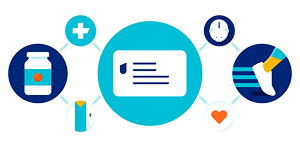- How do your eyes work?
- What causes blurry vision?
- What are some common eye diseases?
- What do I need to know about eye exams?
- What type of eye doctor should I see?
- What can I do to keep my eyes healthy?
- How can vision insurance help keep my eyes healthy?
Being able to see, and hopefully see well, is important whether you’re at work, school or home. When you understand how your eyes function and what can go wrong with them, you can take better care of your sense of sight.
Here is a beginner’s guide to eye health, and what you can do to protect your vision.
The eye is a complex organ with a single very important job: sending sensory information (in the form of light) to your brain.
“Clear vision comes from light traveling in a straight path through the eye to the retina, which is then processed by the brain,” explains Tiffany Gates, O.D., F.A.A.O., F.SL.S. She’s an optometrist and co-owner at Visionary Eye Care in Broomfield, Colorado.
Here’s how your eyes work:
- The cornea is the outermost window of the eye. It’s shaped like a dome to help focus the light that’s entering your eye.
- The pupil is the dark hole in the middle of the eye. That’s where light enters the eye.
- The iris is the colored part of the eye. It controls how much light enters your eye. When you are in a darkly lit place, the muscles of the iris make the pupil get larger (dilate) to allow more light through. When you’re in bright light, the muscles of the iris make the pupil get smaller to let in less light.
- Right behind the pupil sits the lens. The lens focuses light toward the back of the eye. It changes shape depending on whether you are looking at something far away or close up.
- The retina is the back of the eye. The light coming in through your pupil is projected onto the retina. The retina then converts the light to electrical signals that are sent to the brain by way of the optic nerve.
These key parts of the eye have to work together perfectly for you to see well. Each part can also develop problems that can affect your vision or even cause you to lose your sight altogether. That’s why maintaining good eye health is so important.
Does your health insurance not include vision benefits? A standalone vision plan can be an affordable option. Explore one today.
Blurry vision happens when the light that reaches the retina isn’t focused correctly. Such refractive errors, as they’re called, are caused by problems with the shape of your eye or cornea, or problems with your lens.
At least 150 million Americans have a refractive error, making it by far the most common eye problem. Fortunately, refractive errors can usually be fixed with glasses or contact lenses.
These are the most common types of refractive errors:
- Nearsightedness (myopia) is when distant objects look blurry. It happens when your eye is shaped in a way that focuses light in front of the retina instead of on it. Nearsightedness typically starts in kids at around ages 6 to 14, gradually worsening until they’re in their early 20s.
- Farsightedness (hyperopia) is when nearby objects look blurry. It happens when your eye is shaped in a way that focuses light behind your retina instead of on it. People who are farsighted are usually born with the condition, although they may not experience vision problems until later in life.
- Astigmatism can make both near and far objects look blurry or distorted. It happens when your cornea has an irregular shape.
- Presbyopia makes it harder to see things up close (such as reading materials). It’s caused by the aging of your lens. As you get older, your lens loses its elasticity, making it harder to focus on objects correctly. Nearly everyone will experience presbyopia as they age, usually starting at around 45 years old.
How much a refractive error affects your vision varies from person to person. “It’s common for patients to not realize they have a vision problem, especially if it only affects one eye,” says Gates. “Vision changes can happen gradually, so you might not notice a change until you are seen for your annual eye exam.”
Glasses or contact lenses are the most common treatment for refractive errors. There are also surgeries that can correct them.
Ready to explore insurance plans where you live?
Each part of the eye can develop problems that can affect your vision. While a lot of eye diseases are rare, a few affect many Americans each year. The most common, especially among older adults, include:
- Cataracts
- Diabetic retinopathy
- Glaucoma
- Macular degeneration
Here’s an overview:
Cataracts
Around age 40, a cloudy area called a cataract can start to develop on the lens. Cataracts can make your vision cloudy, blurry or washed out. You may also notice halos around lights or have trouble seeing at night. More than 17% of Americans ages 40 and older and half of Americans ages 80 and older have (or have had) cataracts. Treatment involves replacing the cloudy lens with an artificial one.
Diabetic retinopathy
Diabetes affects blood vessels throughout the body, including in the retina. In fact, over half of people with diabetes eventually develop diabetic retinopathy. With this disease, retinal blood vessels can bleed, causing dark spots or streaks in your vision. Left untreated, the problem only gets worse and can lead to blindness. You can reduce your risk by managing your blood sugar levels.
Treatments are available that can keep diabetic retinopathy from getting worse, but they can’t undo the damage it has caused. Catching diabetic retinopathy early is key to preserving your vision. That’s why regular eye exams are so important for people with diabetes.
Glaucoma
Glaucoma is a group of diseases that damage the optic nerve, and they affect about 3 million Americans. With the most common form, open-angle glaucoma, vision loss develops slowly, starting with the peripheral (side) vision. Many people with glaucoma have elevated pressure inside the eye, and reducing that pressure is key to slowing the disease.
Anyone can develop glaucoma, but you face a higher risk if:
- You’re over age 60
- You’re over age 40 and Black
- You have diabetes
- You have a family history of glaucoma
Macular degeneration
The macula is a small area on the retina that is very important for your vision. Age-related macular degeneration (AMD) occurs when the macula gets thinner (dry AMD) or when abnormal blood vessels grow in the macula (wet AMD).
The disease, which affects 11 million Americans, blurs a person’s central vision. It can develop slowly and without symptoms at first, so regular eye exams are important. There’s no cure for macular degeneration, although treatments are available that can stop further vision loss.
An eye exam does much more than check your vision. Eye problems have a way of sneaking up on you. You can detect problems, such as vision loss, early by seeing an eye doctor regularly for a comprehensive eye exam.
“Eye diseases often develop without symptoms, but they can be stopped or slowed with proper treatment,” says Gates. “Once vision is lost, sometimes it cannot be restored.”
A comprehensive eye exam includes a few different tests to check your vision and look for early signs of eye disease. Typical tests include:
- Visual acuity test: During this part of an eye exam, you’ll look at an eye chart with letters of different sizes, which tests how well you can see. If you need glasses to correct your vision, your eye doctor will do more tests to get the prescription just right.
- Visual field test: This tests how well you can see objects off to the side of your vision without moving your eyes. You might be asked to look straight ahead at a screen and click a button when you see something off to the side.
- Eye muscle function test: Your eye doctor will ask you to follow an object that they move around, using just your eyes.
- Pupil response test: Your eye doctor will shine a light in your eyes to see how well your pupil expands and contracts.
- Eye pressure measurement: Also called a tonometry test, this test looks for signs of glaucoma. The test usually involves a machine that blows a small puff of air into each eye.
- Retinal exam: Your eye doctor will use a special lens or machine that will look at your retina through your pupil. You may have your pupils dilated for this part of the test. Your doctor will put drops in your eyes that will cause your pupils to widen for a few hours. This can make your vision blurry or sensitive to light for a few hours after your exam. Bring sunglasses with you — they can help.
Your eye doctor may do more tests depending on your eye health and vision quality.
How often should you get an eye exam? “We recommend annual eye exams, starting at 6 months of age and up,” says Gates. “People with diabetes or glaucoma risk factors should get exams at least once a year, or more frequently if your provider recommends.”
Don’t let cost get in the way of healthy eyes. Explore a vision insurance plan now.
There are 2 main types of eye doctors: optometrists and ophthalmologists. You may also see an optician. Here’s what each does:
- An ophthalmologist is a doctor of medicine (M.D.) or doctor of osteopathy (D.O.) that can diagnose and treat conditions that affect your eyes and vision. They can also do eye surgeries.
- An optometrist is not a medical doctor. They attend optometry school instead of medical school and have a doctor of optometry (O.D.) degree. They can perform comprehensive eye exams and treat common eye diseases and vision problems.
- An optician is a specialist that helps you choose eyeglasses or contact lenses. They cannot treat or diagnose eye conditions.
You can go to an optometrist or ophthalmologist for your yearly comprehensive eye exam. For more serious conditions, such as glaucoma or diabetic retinopathy, you may get referred to an ophthalmologist for more advanced care.
Besides getting regular eye exams, you can also take daily steps to keep your eyes healthy.
Here are 5 things you can do:
- Eat healthy foods. These nutrient-rich foods includes dark, leafy greens such as spinach, as well as fish high in omega-3 fatty acids such as salmon.
- Get active. Being physically active reduces your risk of conditions such as diabetes that can cause eye problems.
- Quit smoking. Smokers face a higher risk of developing cataracts and macular degeneration.
- Protect your eyes. Wear sunglasses that block 99% to 100% of UVA and UVB radiation when outdoors, and wear safety glasses or goggles when playing sports or using tools.
- Rest your eyes. If you spend a lot of time looking at screens, stop every 20 minutes and look at something 20 feet away for 20 seconds.
Depending on the insurance you get, your vision may not be covered. For example, vision care isn’t an essential benefit in Affordable Care Act health plans. It’s also not covered by Medicare, but some Medicare Advantage plans may include vision coverage. A separate vision insurance plan can help cover the cost of regular eye exams and, if you need them, glasses or contact lenses. (You can also bundle a vision plan with a dental plan.)
Eye exams are generally covered once a year. When you pay a copay, or a flat fee for health services, the cost could be as little as $10. Glasses or contacts may be covered with a:
- Copay
- Coinsurance (percentage you pay for health services)
- Set “allowance” every 1 or 2 years. With an allowance, a plan may pay up to $150, for example, for new frames. If your frames cost more than that, you’ll have to pay the rest out of pocket.
You may be limited to certain brands or types of glasses and contacts that your plan covers. Your plan may also have a limited network of providers. Care from an out-of-network provider may cost more or may not be covered at all.
What happens if your eye exam uncovers a health problem such as glaucoma? That’s where your health insurance steps in — vision insurance doesn’t cover medical or surgical treatment of the eyes.
You can enroll in a vision plan at any time. But be sure to read the fine print. Some plans have waiting periods. You may have to be enrolled in the plan for a certain number of months before it will cover your care. A licensed insurance agent can help you find the right vision plan for you and your family. Call one today at 1-844-211-7730.
For informational purposes only. This information is compiled by UnitedHealthcare and does not diagnose problems or recommend specific treatment. Services and medical technologies referenced herein may not be covered under your plan. Please consult directly with your primary care physician if you need medical advice.
Sources:
American Academy of Ophthalmology. “Eye Anatomy: Parts of the Eye and How We See.” March 9, 2021. Retrieved from https://www.aao.org/eye-health/anatomy/parts-of-eye
Centers for Disease Control and Prevention. “Common Eye Disorders and Diseases.” December 19, 2022. Retrieved from https://www.cdc.gov/visionhealth/basics/ced/index.html Accessed March 8, 2023
Centers for Disease Control and Prevention. “Don’t Let Glaucoma Steal Your Sight!” November 24, 2020. Retrieved from https://www.cdc.gov/visionhealth/resources/features/glaucoma-awareness.html Accessed March 8, 2023
Golden Rule Insurance Company. UnitedHealthcare-branded Vision Plans. May 13, 2021. Retrieved from https://www.uhone.com/api/supplysystem/?FileName=44276C1-G202106.pdf
National Eye Institute. “Age-Related Macular Degeneration (AMD).” June 22, 2021. Retrieved from https://www.nei.nih.gov/learn-about-eye-health/eye-conditions-and-diseases/age-related-macular-degeneration
National Eye Institute. “Cataracts.” January 13. 2023. Retrieved from https://www.nei.nih.gov/learn-about-eye-health/eye-conditions-and-diseases/cataracts
National Eye Institute. “Diabetic Retinopathy.” July 8, 2022. Retrieved from https://www.nei.nih.gov/learn-about-eye-health/eye-conditions-and-diseases/diabetic-retinopathy
National Eye Institute. “Farsightedness (Hyperopia).” September 8, 2020. Retrieved from https://www.nei.nih.gov/learn-about-eye-health/eye-conditions-and-diseases/farsightedness-hyperopia
National Eye Institute. “Finding an Eye Doctor.” August 18, 2021. Retrieved from https://www.nei.nih.gov/learn-about-eye-health/healthy-vision/finding-eye-doctor
National Eye Institute. “Get a Dilated Eye Exam.” May 19, 2021. Retrieved from https://www.nei.nih.gov/learn-about-eye-health/healthy-vision/get-dilated-eye-exam
National Eye Institute. “How the Eyes Work.” April 20, 2022. Retrieved from https://www.nei.nih.gov/learn-about-eye-health/healthy-vision/how-eyes-work
National Eye Institute. “Keep Your Eyes Healthy.” May 19, 2021. Retrieved from https://www.nei.nih.gov/learn-about-eye-health/healthy-vision/keep-your-eyes-healthy
National Eye Institute. “Nearsightedness (Myopia).” September 8, 2020. Retrieved from https://www.nei.nih.gov/learn-about-eye-health/eye-conditions-and-diseases/nearsightedness-myopia
National Eye Institute. “Presbyopia.” September 8, 2020. Retrieved from https://www.nei.nih.gov/learn-about-eye-health/eye-conditions-and-diseases/presbyopia
National Eye Institute. “Refractive Errors.” June 10, 2022. Retrieved from https://www.nei.nih.gov/learn-about-eye-health/eye-conditions-and-diseases/refractive-errors
Compliance code:
UHOEYEHUBA1











